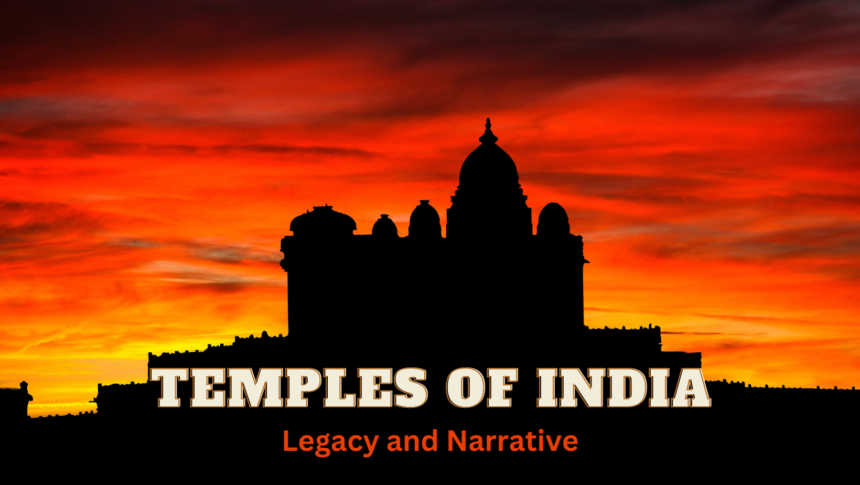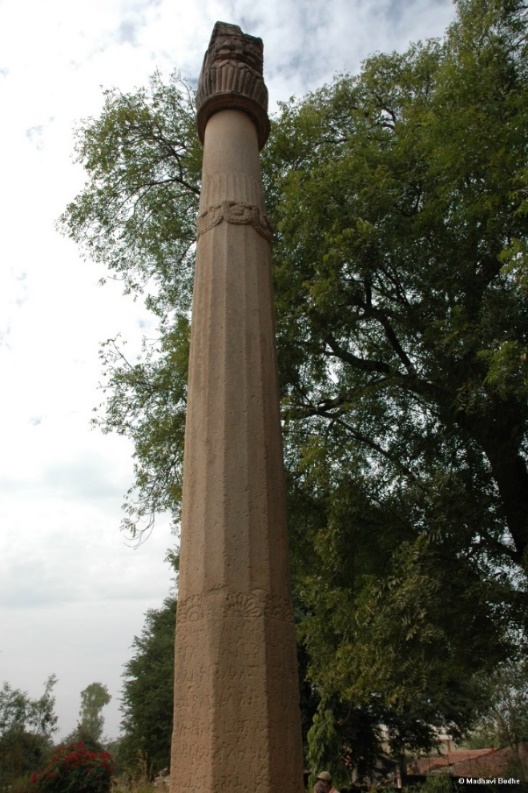Building a separate structure to house murtis, carriers of divinity, for personal and public worship of deities is an old tradition prevalent in India.
Manisha Chitale takes us through the history and evolution of temple architecture in the country and how temples have shaped the Sanatana dharmik civilisation.
Unseen Temples of India – Legacy and Narrative – Part 2

This is the second part of the “Unseen Temples of India” series; part 1 can be read here.
Textual references are supported by physical evidence in the form of inscriptions and archaeological finds.
Inscriptional evidence – text and physical evidence
Inscriptions are texts found on stone or metal plates; inscriptions found at various places add credence to the textual references. Many a time, the inscriptions themselves refer to a date in time. Sometimes the purpose is to advertise the donation and donor for building a temple, providing a grant or something tangible that can be donated. Sometimes inscriptions are for public consumption, such as civic rules as can be seen on Ashoka’s inscription. At times inscriptions are elaborate verses celebrating the victories of a king. Inscriptions are created for posterity.
Our temples throughout history have quite an inscriptional past.
- A glorious lone pillar stands somewhere near Vidisha at a place now known as ‘Khamb Baba’. This pillar has an inscription dated to 200 BCE when a certain Greek ambassador named Heliodorus from Taxila, was a worshipping ‘Bhagvata’, a devotee of Vishnu, and hence built a ‘Garud Standard’. Later excavations at the same site discovered an extensive elliptical temple base with a plinth suggesting all components of an ancient Indian temple viz. Garbhagriha, Antaral and Rangmandap. Of course, the pillar had company when it was constructed![S1]
Even today we see several examples of ‘Garud Stambh’ – Eagle tower built in the premise of Vishnu Temple e.g. Chennakeshava at Belur, Karnataka, and Lakshmi-Narayana Temple in Chamba, Himachal Pradesh.

- A similar inscription was found in Nagari and Ghosundi in Rajasthan which mentions a temple known as Narayana Vatika dedicated to deities Samkarshana and Vasudeva. This inscription is dated around 200 BCE, as per the ASI. It refers to ‘pujashila-praakar’ for the deities. Krishna-Balrama temples are prevalent even today, the most famous one being the Jagannatha temple at Puri, Odisha.[S2]
- An inscription found in Mathura, dated around the First Century CE describes the temple as a mountain with an assembly hall and stone slabs. This indicates that temple construction and temples structures were well-established. It was considered a privilege and honour to build a temple dedicated to deities.[S3]
- An inscription found at Mandsour in Madhya Pradesh, attributed to Kumar Gupta, mentions that a guild of silk weavers built a temple dedicated to Surya, the Sun God, in Dashpur in 436 AD. Temple building was a prevalent activity, and it was supported by not only the Kings but also traders and their guilds.[S4]
- Several Himalayan temples in wood and stone get rebuilt every few years. Existing ancient temples can also be dated based on the date mentioned in the inscription, if any are found nearby. In the case of the Changu Narayana Temple in Nepal, though the current structure was built in the eighteenth century, an inscription found on the wall mentions kings of the region and is dated around 464 CE, thus extending the legacy of the temple site.
These inscriptions, cast in stone or metal, provide the missing link between purely textual and purely archaeological evidence. These inscriptions are like geo-tagged messages from the past telling us about the event and the location and sometimes time, all together.
Archaeological finds of temples
Although the experts in the field have concluded that early-standing structural temples in stone can only be found during the Gupta era (400 CE onwards), several excavations in the past and present have unearthed lost temples that can be dated further back in history.
- Mundeshwari temple in the Kaimur Hills near Sasaram, Bihar is a fine example of temple architecture with an octagonal plan. The hill is replete with several broken building blocks of temples such as Amalaka, pillars, and many sculptures. This could very well be a temple cluster. The presence of a four-faced Shivlingam in the temple itself points to the possibility of another Shiva Temple. Eras and Kings mentioned in the inscription found at the temple site along with another recently discovered Srilankan seal have led the ASI to determine the date of this temple to be 108 CE. Hien Tsang has also mentioned a temple on top of the hill, south of Patna, which could very well be Mundeshwari.[S5]
- Excavations at Lal Tilai in the Hardoi district of UP have unearthed a temple built during the Shunga Era, around 200 BCE. This apsidal or U-shaped temple plinth has construction material typical of the Shunga era. The archaeologists have been able to identify the entrance, the mandapa, and Garbha-griha of this temple.[S6]
- At nearby Sanchankot, similar brick-based foundations of a Shiva temple have been found. Archaeologists have carbon-dated the material to ~2300 years past. Such discoveries corroborate the references found in ancient texts about the existence of temples and temple traditions.[S7]
- In another excavation at Bilsarh in Uttar Pradesh, a temple staircase, and an inscription, date the temple ruins to the times of King Kumaragupta I of the Gupta dynasty whose ruling period was from 415- 455 CE. All these examples and many more excavation findings make it evident that elaborate temples were being built and reconstructed as well.
As we all know, worship of Murtis in temples is a public activity, accessible to all. Visiting temples, festivals woven around the temple deities, construction of new temples, and other such events had become a part of social life for the last several millennia.
Current Narrative
The current discourse tells us that the Gupta era (400 CE onwards) temples were the first temples of India. Although, it is acknowledged that temples existed prior to the Gupta era, the fact is hardly highlighted.
A simple google search results in something like this.

Some popular mythologists brazenly state that ‘Temples appear much later in Indian history, after the composition of the Puranas, 1500 years ago, and are linked to a rise in feudalism and land grants.’ and get away with the distortion.[S8]
Historians say that Hindu temples did not exist during the Vedic period (1500–500 BCE). According to historian Nirad C. Chaudhuri, the earliest structures that indicate murti pooja date back to the 4th or 5th century CE.
The above are just a few representative samples forming the current narrative.
However, considering the cultural memory and traditional knowledge along with data points of several physical and scriptural references, we are forced to rethink this temple tradition related narrative.
Yes, the Gupta-era temples are the first standing temples that we see today; however, they certainly do not represent the beginning of the temple-building tradition.

Counter narrative
Here are 4 reasons why the current narrative regarding the history of temple tradition needs to be revised.
- Unreliable dating of textual references:
Textual references of temples provide insight into temple tradition and deity worship. Placing them on a timeline will provide accurate historical chronology of murti pooja and temple constructions. Dating of scriptural references such as Vedic texts, Mahabharata, Puranas, and other scholarly works such as Ashtadhyayi or Arthshastra is done based on the style of language (Sanskrit), mention of other scriptures, kings, geographies in the same text.
The primary problem is that the dating of these texts cannot be verified and there is no unanimity among scholars and historians regarding the time of these texts.
Different experts have dated the texts in different eras based on their views and findings. For example, the Rigveda, the oldest of the Vedic literature is placed in 1500 BC by MaxMuller, in 3000 BC by Jacobi, in 1100 BC by Ludwig, and in 6000-7000 BCE by recent scholars.[S9] Dating of Mahabharata, Ramayana, and Puranas, which are full of temple references, is taken as their compilation dates and they range from 400 BCE to 400 CE. The date of Panini and Patanjali cannot be determined conclusively.[S10] As a result, the temple traditions mentioned in those texts can very well be traced into earlier indeterminate centuries and eras. - Limitation of inscriptional evidence and their dating: The dating of inscriptions is done based on the date mentioned in it, which could be a year from the prevalent calendar (Shaka or Samvat). In case of the absence of such a year, the date of the inscription is determined based on the size and form of characters and mentions of contemporary kings. As per the current understanding, inscriptions prior to the Mauryan era are not found (300 BCE). At the same time, we see several inscriptions from 200 BCE to 200 CE, across Indian geography mentioning the construction and reconstruction of temples and the deities worshipped.[S11] For example, the Vasu door jamb and Mora well inscription found at Mathura are one of the several inscriptions which mention the temples of Vasudeva. The famous Hathigumpha inscription of Kharwel in Odisha mentions him as a ‘Repairer of Temples’. The Ghosundi inscription in Rajasthan mentions a Vatika for Narayana, the deity. An inscription found in Guntur, Andhra Pradesh mentions the construction of a temple of Bhagavati and SaptaMatrika. This indicates widespread temple traditions across India. Mentions of repairs and reconstruction indicate long-standing history of building and preservation of temples. Hence the temple tradition would certainly predate 300 BCE, as popularly believed.
- Archaeological evidence of temples: Discoveries of temple plinths dating several centuries before the Gupta era along with scriptural and inscriptional pointers which again can be dated much in the past, support the idea that temples were part of society much before. Temples were built in stone, brick, mortar, timber, or metal as evident through an inscription by Mahendravarman Pallava (600-630 CE) at Mandagpattu cave temple.[S12]
- ‘Beginning’ temples show enormous craftsmanship in terms of sculptures: Gupta-era temples are assumed to be the beginning of structural temple tradition and are termed primitive due to the lack of elaborate temple structure. These temples at Deogarh, Sanchi, and Nachana have only Garbhagriha, very simple or broken Shikhara, and no Sabha-mandap or outer hall. However, Sheshshayi Vishnu at Devgarh, the concept of Ayudh Purush in the same temple, and highly ornate single-face Shivlingam at Bhumara are highly evolved ideas and must be in practice for a longer time. Treating these successors of pre-existing tradition as the ‘beginning of temple tradition in India’ or calling them ‘primitive’ is plain wrong. As we can see, scriptural and inscriptional dating are prone to revision when new evidence comes into the picture or new interpretations sound more logical. Hence historical data can be reinterpreted, and new narratives will get formed based on facts and artefacts.
For now, it is safe to conclude that the temple tradition of the Indian subcontinent is as old as its history gets explored in earlier and earlier centuries with newer research and newer reasonings.
After all, we are observers of the eternal passage of time. With our limited knowledge, we try to decipher the lives of our ancient relatives. The joy of finding a trace, knowing a little more, understanding a new viewpoint, and bliss in this exploration is the coveted prize!
Note:
All data points mentioned in the article are available in the public domain.
References:
[ S1 ] https://www.academia.edu/3360811/Haliodorous_Pillar_of_Besnagar_Past_and_Present_pp_13_19_
[ S2 ] http://nmma.nic.in/nmma/antiqDetail.do?refId=874522&object=33
[ S3 ] https://en.wikipedia.org/wiki/Mountain_Temple_inscription
[ S4 ] https://www.academia.edu/11335052/The_Mandasor_Silk_Weavers_Inscription_of_437_CE_and_the_Temples_of_the_Aulikaras
[ S5 ] https://tourism.bihar.gov.in/en/destinations/kaimur/mundeshwari-devi-temple#:~:text=Maa%20Mundeshwari%20Devi%20Temple%20is,a%20protected%20monument%20since%201915.
[ S6 ] https://defenceforumindia.com/threads/early-mauryan-temples-discovered-in-hardoi.51245/
[ S8 ] https://devdutt.com/articles/what-was-hinduism-like-before-temples/
[ S9 ] History of ancient and early Medieval India -Upinder Singh
[ S10 ] https://mathshistory.st-andrews.ac.uk/Biographies/Panini/
[ S11 ] http://gdckulgam.edu.in/Files/f07ef270-7e91-4716-8825-2966f17cc0f7/Custom/Epigraphy.pdf
[S12 ] https://commons.wikimedia.org/wiki/File:Mandakapattu_Inscription.jpg

Leave a Reply